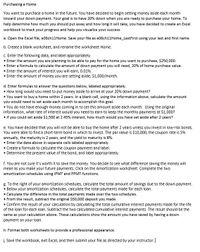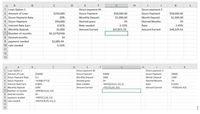
Essentials Of Investments
11th Edition
ISBN: 9781260013924
Author: Bodie, Zvi, Kane, Alex, MARCUS, Alan J.
Publisher: Mcgraw-hill Education,
expand_more
expand_more
format_list_bulleted
Question
thumb_up100%
I have an excel project I'm having trouble with. I need to use financial formulas but I'm not getting the appropriate results. I have completed questions a-d. When using the Rate formula, to achieve $50,000 in a matter of 2 years saving $1,000 a month, i get a rate of -5.55%. When testing this out using the FV formula, the total does not come out to $50,000 but instead I get $47,871.55. I need help correcting this formula. I'm including screen shots of the entire instruction packet as well as the excel screen shots. The first excel sreen shots show my results and the second one shows the formulas used.

Transcribed Image Text:Purchasing a Home
You want to purchase a home in the future. You have decided to begin setting money aside each month
toward your down payment. Your goal is to have 20% down when you are ready to purchase your home. To
help determine how much you should put away and how long it will take, you have decided to create an Excel
workbook to track your progress and help you visualize your success.
a. Open the Excel file, e06ch11Home. Save your file as e06ch11Home_LastFirst using your last and first name.
b. Create a blank worksheet, and rename the worksheet Home.
c. Enter the following data, and label appropriately.
• Enter the amount you are planning to be able to pay for the home you want to purchase, $250,000.
• Enter a formula to calculate the amount of down payment you will need, 20% of home purchase value.
• Enter the amount of interest you will earn, 0.01%.
• Enter the amount of money you are setting aside, $1,000/month.
d. Enter formulas to answer the questions below, labeled appropriately.
• How long would you need to put money aside to arrive at your 20% down payment?
• You want to buy a home within 2 years. In a blank cell, using the information above, calculate the amount
you would need to set aside each month to accomplish this goal.
• You do not have enough money coming in to set this amount aside each month. Using the original
information, what rate of interest would you need to earn to keep the monthly payments at $1,000?
• If you could set aside $1,500 at 2.45% interest, how much would you have set aside after 2 years?
e. You have decided that you will not be able to buy the home after 2 years unless you invest in low-risk bonds.
You were able to find a short-term bond in which to invest. The par value is $10,000, the coupon rate is 5%
annually, the maturity is 2 years, and the yield to maturity is 8%.
• Enter the data above in separate cells labeled appropriately.
• Create a formula to calculate the coupon payment and label.
• Determine the present value of the bond, and label appropriately.
f. You are not sure it's worth it to save the money. You decide to see what difference saving the money will
mean as you make your future payments. Click on the Amortization worksheet. Complete the two
amortization schedules using IPMT and PPMT functions.
g. To the right of your amortization schedules, calculate the total amount of savings due to the down payment.
• Below your amortization schedules, calculate the total payments made for each loan.
• Calculate the difference in the total payments made over the two schedules.
From the result, subtract the original S50,000 deposit you made.
• Confirm the result of your calculation by calculating the total cumulative interest payments made for the life
of the loan for each loan. Subtract the two calculated cumulative interest payments. The result should be the
same as your calculation above. These calculations show the amount you have saved by having a down
payment on your loan.
h. Format both worksheets to provide a professional appearance.
į. Save the workbook, exit Excel, and then submit your file as directed by your instructor.

Transcribed Image Text:B
D
F
H
K
1 Loan Option 1
Down payment #2
Down payment 3
2 Amount of Loan
3 Down Payment Rate
4 Down Payment
5 Interest Rate Earn
6 Monthly Deposit
7 Number of months
8 Desired months
9 payment needed
$250,000
$50,000.00
$1,000.00
$50,000.00
$1,500.00
Down Payment
Down Payment
20%
Monthly Deposit
Month Deposit
$50,000
Desired years
24
Desired Months
24
0.01%
Rate needed
-5.55%
Rate
2.45%
$1,000
Amount Earned
$47,871.55
Amount Earned
$48,224.63
50.12792446
24
$2,085.94
10 rate needed
-5.55%
11
12
13
A
F
H
K
1 Loan Option 1
2 Amount of Loan
3 Down Payment Rate
4 Down Payment
5 Interest Rate Earn
6 Monthly Deposit
7 Number of months
8 Desired months
9 payment needed
10 rate needed
Down payment #2
Down Payment
Down payment 3
Down Payment
Month Deposit
250000
S0000
50000
0.2
Monthly Deposit
1000
1500
SUM(C2*C3)
Desired years
24
Desired Months
24
0.0001
Rate needed
=RATE(G4,G3,-G2,1)
Rate
0.0245
1000
Amount Earned
-FV[-G5,G4,-G3)
Amount Earned
-FV(K5,K4,-K3)
=NPER(CS,C6,-C4)
24
=PMT(C5,C8,-C4)
RATE(C8,C6,-C4,1)
11
12
Expert Solution
This question has been solved!
Explore an expertly crafted, step-by-step solution for a thorough understanding of key concepts.
This is a popular solution
Trending nowThis is a popular solution!
Step by stepSolved in 3 steps with 2 images

Knowledge Booster
Learn more about
Need a deep-dive on the concept behind this application? Look no further. Learn more about this topic, finance and related others by exploring similar questions and additional content below.Similar questions
- Please complete this practice problem by using the 2 images below. Please write cleary and everything in order. Thank youarrow_forwardWilma is considering opening a widget factory. The unlevered cost of equity for making widgets is 0.1. This factory would cost $10 million to set up, and would produce EBIT of $3 million per year for the foreseeable future. She is thinking of applying for a $3 million subsidized perpetual loan to finance this project. Complying with the auditing requirements of this loan would have a present value of $2 million. This loan would have a rate of 0.04, while the rate she could get from the bank is 0.07. Her tax rate is 0.41. What is the NPV of this project, using the APV method?arrow_forwardPlease don't use hend raiting and step by step solutionsarrow_forward
arrow_back_ios
arrow_forward_ios
Recommended textbooks for you
 Essentials Of InvestmentsFinanceISBN:9781260013924Author:Bodie, Zvi, Kane, Alex, MARCUS, Alan J.Publisher:Mcgraw-hill Education,
Essentials Of InvestmentsFinanceISBN:9781260013924Author:Bodie, Zvi, Kane, Alex, MARCUS, Alan J.Publisher:Mcgraw-hill Education,

 Foundations Of FinanceFinanceISBN:9780134897264Author:KEOWN, Arthur J., Martin, John D., PETTY, J. WilliamPublisher:Pearson,
Foundations Of FinanceFinanceISBN:9780134897264Author:KEOWN, Arthur J., Martin, John D., PETTY, J. WilliamPublisher:Pearson, Fundamentals of Financial Management (MindTap Cou...FinanceISBN:9781337395250Author:Eugene F. Brigham, Joel F. HoustonPublisher:Cengage Learning
Fundamentals of Financial Management (MindTap Cou...FinanceISBN:9781337395250Author:Eugene F. Brigham, Joel F. HoustonPublisher:Cengage Learning Corporate Finance (The Mcgraw-hill/Irwin Series i...FinanceISBN:9780077861759Author:Stephen A. Ross Franco Modigliani Professor of Financial Economics Professor, Randolph W Westerfield Robert R. Dockson Deans Chair in Bus. Admin., Jeffrey Jaffe, Bradford D Jordan ProfessorPublisher:McGraw-Hill Education
Corporate Finance (The Mcgraw-hill/Irwin Series i...FinanceISBN:9780077861759Author:Stephen A. Ross Franco Modigliani Professor of Financial Economics Professor, Randolph W Westerfield Robert R. Dockson Deans Chair in Bus. Admin., Jeffrey Jaffe, Bradford D Jordan ProfessorPublisher:McGraw-Hill Education

Essentials Of Investments
Finance
ISBN:9781260013924
Author:Bodie, Zvi, Kane, Alex, MARCUS, Alan J.
Publisher:Mcgraw-hill Education,



Foundations Of Finance
Finance
ISBN:9780134897264
Author:KEOWN, Arthur J., Martin, John D., PETTY, J. William
Publisher:Pearson,

Fundamentals of Financial Management (MindTap Cou...
Finance
ISBN:9781337395250
Author:Eugene F. Brigham, Joel F. Houston
Publisher:Cengage Learning

Corporate Finance (The Mcgraw-hill/Irwin Series i...
Finance
ISBN:9780077861759
Author:Stephen A. Ross Franco Modigliani Professor of Financial Economics Professor, Randolph W Westerfield Robert R. Dockson Deans Chair in Bus. Admin., Jeffrey Jaffe, Bradford D Jordan Professor
Publisher:McGraw-Hill Education